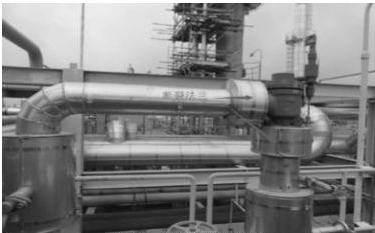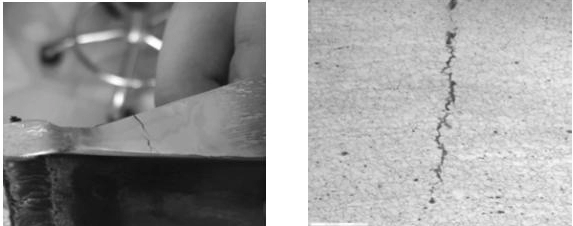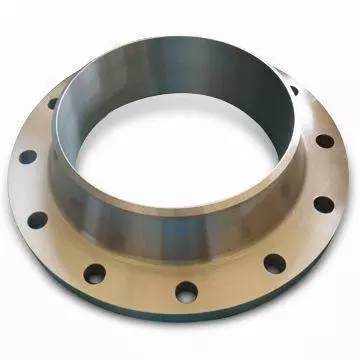Leakages of stainless steel flanges in refrigeration units of petrochemical equipment
Abstract
there are often dangerous factors such as flammable, explosive, high temperature, high-pressure, cryogenic, toxic and harmful and corrosive factors in the petrochemical production, processing, storage and transportation. Because high temperature, high pressure and deep cold can improve production efficiency, reduce energy consumption and obtain better economic benefits, the petrochemical production technology is developing towards a higher level, resulting in increasing risks. Studying the structural characteristics of petrochemical plants will help reduce or eliminate hazards caused by accidents.
1. Defects
The refrigeration unit A and B of a petrochemical device in Zhuhai leak. The pipes were checked after the production was stopped, and it was found that 13 flanges had cracks near the raised part of the flange (Figure 1). The statistics of the flanges are shown in the Table 1 and 2, among which the longest crack has circled the flange, and the deepest crack has penetrated the flange. The operating pressure of this section of the pipeline is 3MPa; the operating temperature is -40℃ (The cold box inlet is -80℃.); the operating medium is natural gas and the outer surface of the pipeline is a cold insulation layer (Figure 2).
Table 1 Statistics of cracked flanges found in the refrigeration unit A
there are often dangerous factors such as flammable, explosive, high temperature, high-pressure, cryogenic, toxic and harmful and corrosive factors in the petrochemical production, processing, storage and transportation. Because high temperature, high pressure and deep cold can improve production efficiency, reduce energy consumption and obtain better economic benefits, the petrochemical production technology is developing towards a higher level, resulting in increasing risks. Studying the structural characteristics of petrochemical plants will help reduce or eliminate hazards caused by accidents.
1. Defects
The refrigeration unit A and B of a petrochemical device in Zhuhai leak. The pipes were checked after the production was stopped, and it was found that 13 flanges had cracks near the raised part of the flange (Figure 1). The statistics of the flanges are shown in the Table 1 and 2, among which the longest crack has circled the flange, and the deepest crack has penetrated the flange. The operating pressure of this section of the pipeline is 3MPa; the operating temperature is -40℃ (The cold box inlet is -80℃.); the operating medium is natural gas and the outer surface of the pipeline is a cold insulation layer (Figure 2).
Table 1 Statistics of cracked flanges found in the refrigeration unit A
| Items | Flange descriptions | Quantities | Flange positions |
| 1 | 3" WN-RF 300LB SCH40 SS304 | 2 | Inlets and outlets of safety valves |
| 2 | 4" WN-RF 150LB SCH40 SS304 | 2 | Inlets and outlets of safety valves |
| 3 | 8" WN-RF 150LB SCH40 SS304 | 2 | Inlets and outlets of safety valves |
Table 2 Statistics of crack flanges found in the refrigeration unit B
| Items | Flange descriptions | Quantities | Flange positions |
| 1 | 3" WN-RF 300LB SCH40 SS304 | 2 | Inlets and outlets of safety valves |
| 2 | 4" WN-RF 150LB SCH40 SS304 | 2 | Inlets and outlets of safety valves |
| 3 | 8" WN-RF 150LB SCH40 SS304 | 2 | Inlets and outlets of safety valves |
| 4 | 12" WN-RF 300LB SCH40 SS304 | 1 | Inlets of cold boxes |

Fig. 2 Fracture positions of flanges
6 cracked flanges with different specifications were sampled and analyzed in the laboratory; the results are as follows:
(1) Hardness inspection: test the hardness near the cracks, and then test the same position on the flange of the pipe without cracks at the same time; the testing results are basically the same.

Fig.3 Metallographic phase detection of flanges
(2) Metallographic inspection: the cracks are cracks along the crystal; part of the cracks are
found on the outer surface or inner surface (Figure 3).
(3) Spectral analysis shows that the carbon content of the flange exceeds the standard, and the chromium and nickel content are not up to the standard. See the Table 3.
Table 3 Spectral analyses of flanges
| Items | Flange sizes | C | Si | Mn | P | S | Cr | Ni | Mo |
| 1 | 3" | 0.095 | 0.627 | 1.559 | 0.0285 | 0.0113 | 17.75 | 7.83 | 0.165 |
| 2 | 3" | 0.142 | 0.435 | 1.544 | 0.0297 | 0.0064 | 17.49 | 7.65 | 0.157 |
| 3 | 4" | 0.139 | 0.492 | 1.611 | 0.0329 | 0.0062 | 17.2 | 7.36 | 0.162 |
| 4 | 8" | 0.148 | 0.445 | 1.569 | 0.0305 | 0.0056 | 17.41 | 7.61 | 0.159 |
| 5 | 8" | 0.122 | 0.321 | 0.954 | 0.038 | 0.0147 | 16.79 | 7.49 | 0.455 |
| 6 | 12" | 0.162 | 0.822 | 1.262 | 0.0297 | 0.0111 | 18.11 | 8.06 | 0.255 |
2. Analyses of main reasons
The main reason for flange cracks is that the flange material does not meet the requirements; the affinity between carbon and chromium is good. Therefore, when the carbon content is too high, it is easy to form Cr23C6 with chromium at the grain boundary, resulting in a decline in the chromium content in the grain boundary and adjacent areas and forming a chromium depleted zone, which make the material prone to intergranular corrosion and affect the corrosion resistance of the material. Nickel is an austenite stabilizing element. Nickel can expand the austenite phase area, inhibit the formation of phases and form a dense oxide film on the metal surface to prevent the body metal from continuing to oxidize. Insufficient nickel content aggravates the occurrence of corrosion fracture of flanges. Intergranular corrosion occurs between 450℃ and 850℃, which is the sensitization temperature zone for intergranular corrosion. The location of the crack is near the welding seam at the end of the flange neck; the reason is that the temperature in this part of the area is in the sensitizing temperature zone in the welding process, and intergranular corrosion cracking is more likely to occur.
The secondary cause of flange cracking is that flanges are subjected to alternating loads. It is found that the pipeline discharges many times after exceeding its pressure due to unstable operation. The conveying medium has caused a greater impact on the pipeline's flange. The petrochemical device is located in the coastal area. Condensed water accumulates under the cold insulation layer of the low-temperature pipeline, and there are plenty of of chloride ions in the condensed water, thus forming a stress corrosion environment, which are the causes of the flange cracking from the outer surface.
 3. Preventive measures
3. Preventive measures(1) Strictly control the quality of pipes and pipe fittings. In the early stage of pipeline installation and construction, the user or purchaser needs to strictly control the raw materials; verify whether they meet the requirements of relevant standards and specifications; conduct inspections and tests before the material leaves the factory. Strengthen the construction, supervision and joint inspection with owners before the engineering materials entering the site. If conditions permit, an independent third party can be participating in the joint inspection. Try to use stainless steel with ultra-low carbon as far as possible to reduce the content of impurities in the steel and the sensitivity of austenitic stainless steel to intergranular corrosion.
(2) Optimize the welding process. In the process of welding, the current can be increased by increasing the welding speed to maintain a low heat input, thereby reducing the tendency of intergranular corrosion. Solution and stabilization treatment can also be performed for stainless steel that is welded so as to reduce the intergranularity of the welded parts.
(3) Perform non-destructive testing to regularly spot check for pipelines that are in the use. Non-destructive testing should be carried out regularly for pipelines operated in the coastal areas and under stress corrosion environments to find defects as early as possible and deal with them in time to avoid major accidents.
(4) Strictly monitor operation. Try to keep the equipment in a stable running state; avoid over temperature and pressure, and try to avoid great fluctuations in system pressure and temperature.
Related News
- Installation of Main Bolts for Lap Joint Flange in High-Temperature Gas-Cooled Reactors
- Structural Design and Finite Element Analysis of Anchor Flanges
- Key Welding Technology for High-Neck Flange and Steel Pipe Joints
- The Design and Calculation of Stamped Lap Joint Flanges
- Development of Manufacturing Large Anchor Flanges
- Hardfacing the Inner Surface of Long-Neck Flanges Using CO₂ Gas-Shielded Welding
- UHV High-Neck Flange Welding
- Application of High-Neck Flange to UHV Steel Pipe Tower
- Analysis of the Cracking Cause of High-Neck Flanges
- Anchor Flanges for the East-West Gas Transmission Project
